Art Criticism
TikTok Star Devon Rodriguez Is Now the Most Famous Artist in the World. But What About His Work?
"Underground," Rodriguez's show at UTA Artist Space, is a chance to observe the rise of Influencer Art.
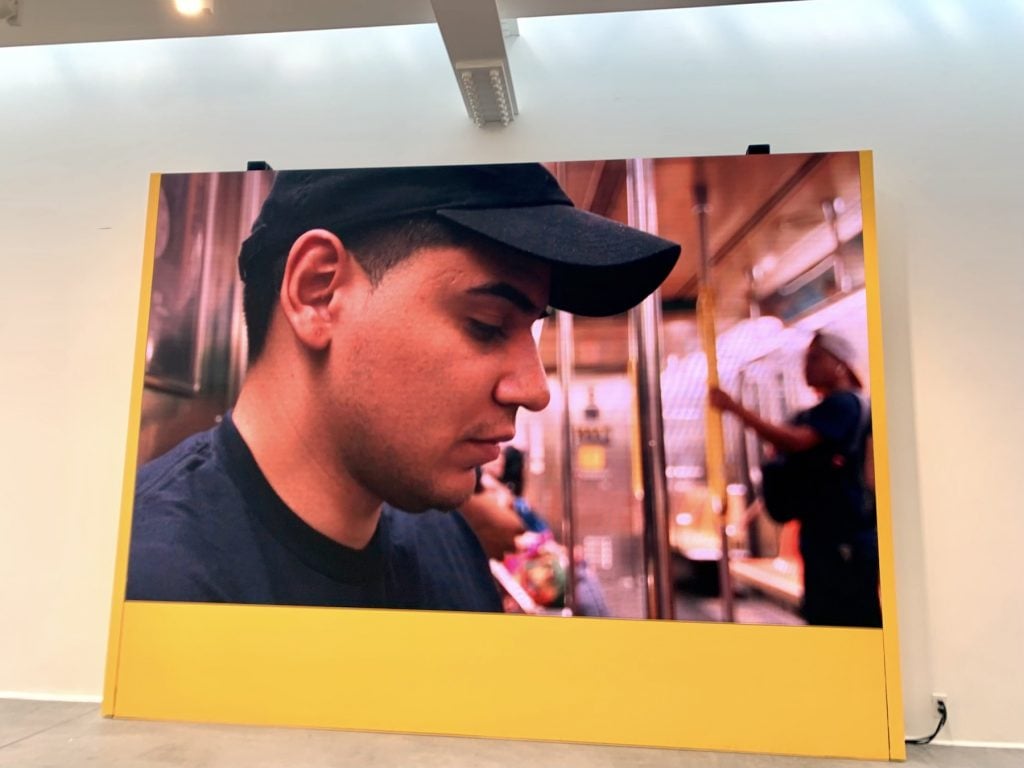
"Underground," Rodriguez's show at UTA Artist Space, is a chance to observe the rise of Influencer Art.

Ben Davis

Devon Rodriguez is almost certainly the most famous artist in the world, at least on one level. Almost no one I know has ever heard of him. Except if you say: “he’s the painter who draws people on the subway, from TikTok.” Then sometimes they will light up with recognition.
He has just closed a solo show titled “Underground,” his first, and everything about it reflects exactly this strange combination of hypervisibility and invisibility. It was in Chelsea, New York’s blue-chip art hub, but was not at an actual gallery. Instead, it was a pop-up staged by UTA Artist Space, the art arm of the Hollywood talent agency that inked a deal to represent Rodriguez “across all media” in 2021.
When I showed up for the opening back at the beginning of September, the line of fans stretched from 10th Avenue to 11th. Along with many dozens of other people, I failed to get in. The opening of “Underground” was a real event, covered on CNN. For many, Rodriguez is both a celebrity and a role model, representing a new pathway to success.
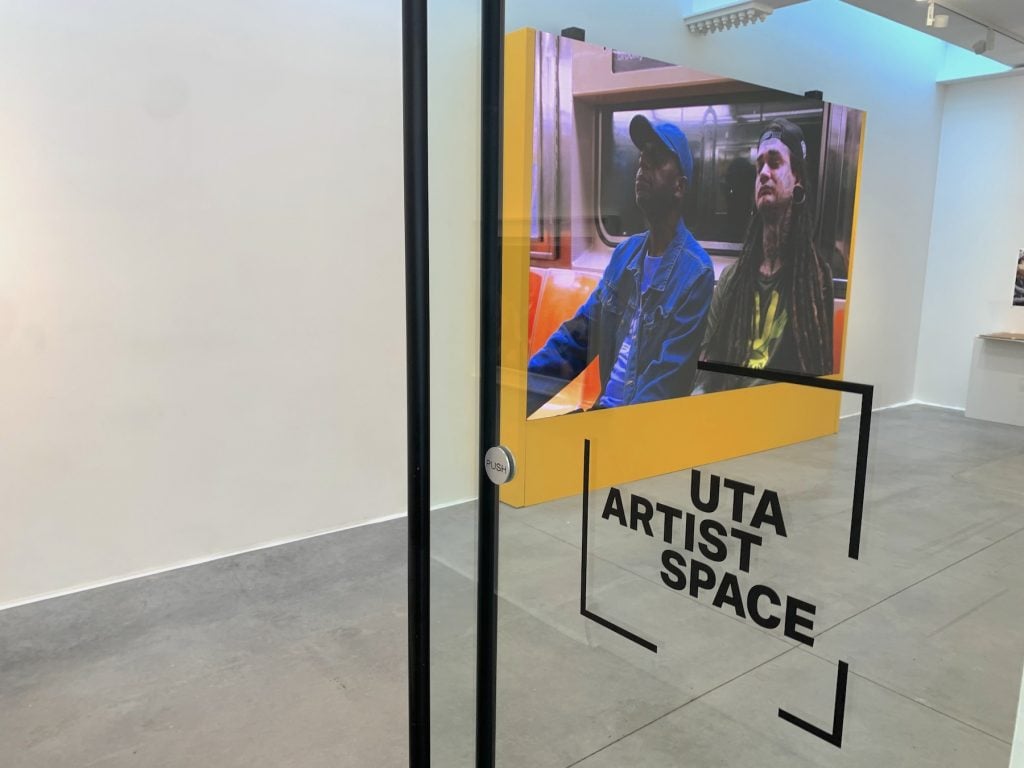
Entrance to “Underground” at UTA Artist Space pop-up space in Chelsea. Photo by Ben Davis.
Born in 1996, Rodriguez grew up in poverty in the South Bronx, one of the poorest neighborhoods in the country. He was abandoned by his father; Child Protective Services removed him from his mother at an early age to live with his grandmother. He did graffiti, eventually discovering painting through supportive high school teachers. In the mid-2010s, he dropped out of the Fashion Institute of Technology to pursue a career in art, his painting catching the eye of legendary Bronx artist John Ahearn when it was in a group show. In 2016, Ahearn would go on to submit a likeness of the then-20-year-old artist to a portrait contest at the Smithsonian, giving Rodriguez some of his first press.
In an article about their friendship in the New Yorker that year, Rodriguez was described as teaching Ahearn how to promote his art on social media. Smash cut to 2020, when Rodriguez had the life-altering inspiration to post to the suddenly ubiquitous platform TikTok. Instead of just showing off his drawings themselves, Rodriguez filmed himself clandestinely making art on the subway, gifting strangers a drawing of themselves and then capturing their emotional reactions.
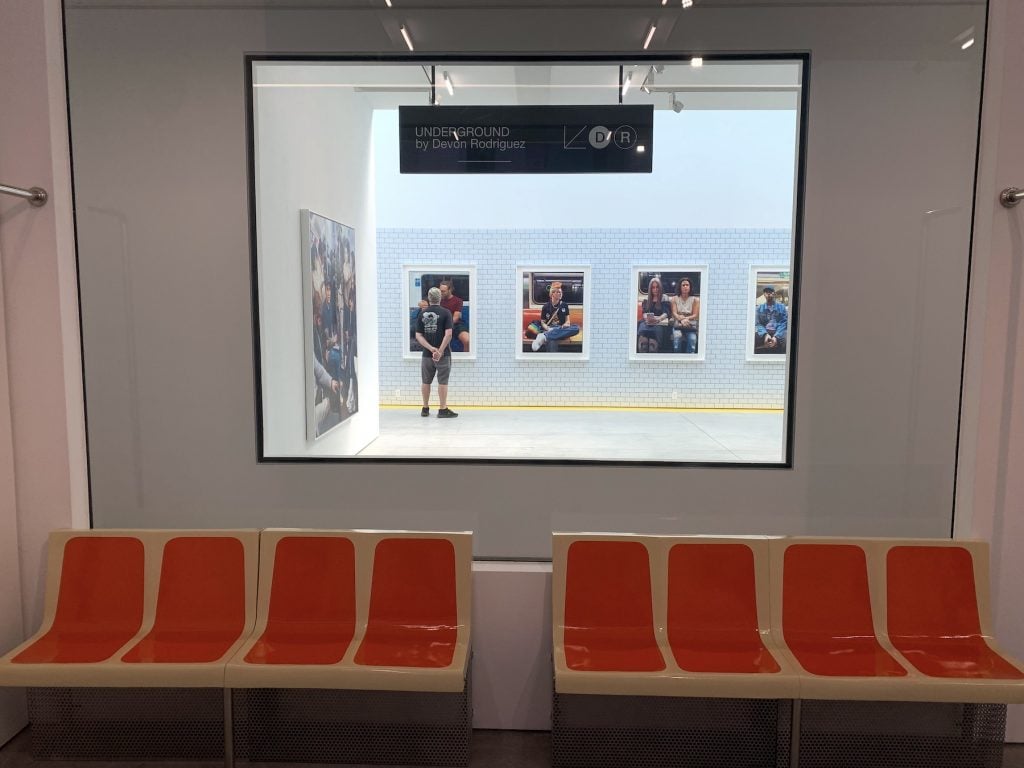
Installation view of “Underground” at UTA Artist Space. Photo by Ben Davis.
He hit pay dirt.
Almost immediately, Rodriguez’s subway vignettes were getting millions, sometimes tens of millions, of views. As of now, Rodriguez has over 32.5 million followers on TikTok, and many millions more across other platforms. According to a 2021 New York Times article about him moving from the Bronx to the Lower East Side, Rodriguez’s day rate for doing sponsored content can be $20,000 to $30,000. Last November, he met president Joe Biden, who accepted a Rodriguez drawing of himself, marveling, “It looks like a photograph!”
“Underground” featured about a dozen paintings in a detailed, photographic style, plus some nicely rendered charcoal drawings. All depict Rodriguez’s signature theme: people riding the subway, reading or looking at their phones or lost in thought.
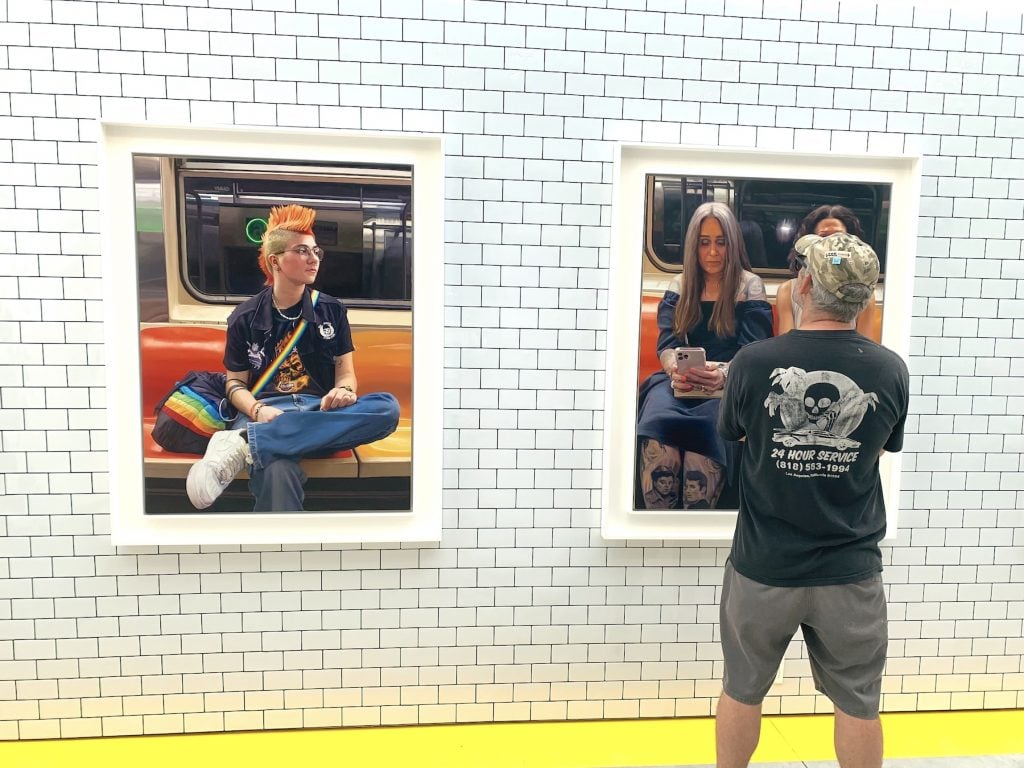
A visitor looks at paintings in “Underground.” Photo by Ben Davis.
A few days after my failed attempt to go to the opening, I went back to the pop-up on a wan weekday afternoon. Then, only a trickle of people came in and out. It felt pretty much like any other gallery in Chelsea, except that UTA had given the space a subway-themed white tile treatment to go with the subway theme of his show, and some MTA-style hard plastic orange seats.
In a statement for the show titled “Deeper Underground,” UTA Artist Space boss Arthur Lewis waxes poetic about Rodriguez’s vision:
In his hands, a single brushstroke becomes an orchestra, a dance, a poignant conversation frozen in pigment. Devon’s creations transport us to a realm where colors converse, shadows whisper, and emotions transcend their two-dimensional confines. His art embodies the essence of what it means to be human—to observe, to interpret, and to share.
Well, he’s an excellent technical painter—there’s a reason why his art would have stood out to someone like John Ahearn. But even by the standards of press-release hype, Lewis is overselling it. The brushstrokes are determinedly inexpressive, not “a poignant conversation frozen in pigment.” As for the colors, the paintings mainly look as if Rodriguez has tried to stay as close to a photographic reference as possible.
Rodriguez’s subject matter has pathos: subway riders lost in their own worlds. But it is somewhat conventional as well. Rodriguez was inspired by, among others, his teacher at the High School of Art and Design, the painter James Harrington, who mines strikingly identical subject matter in a slightly more painterly way.
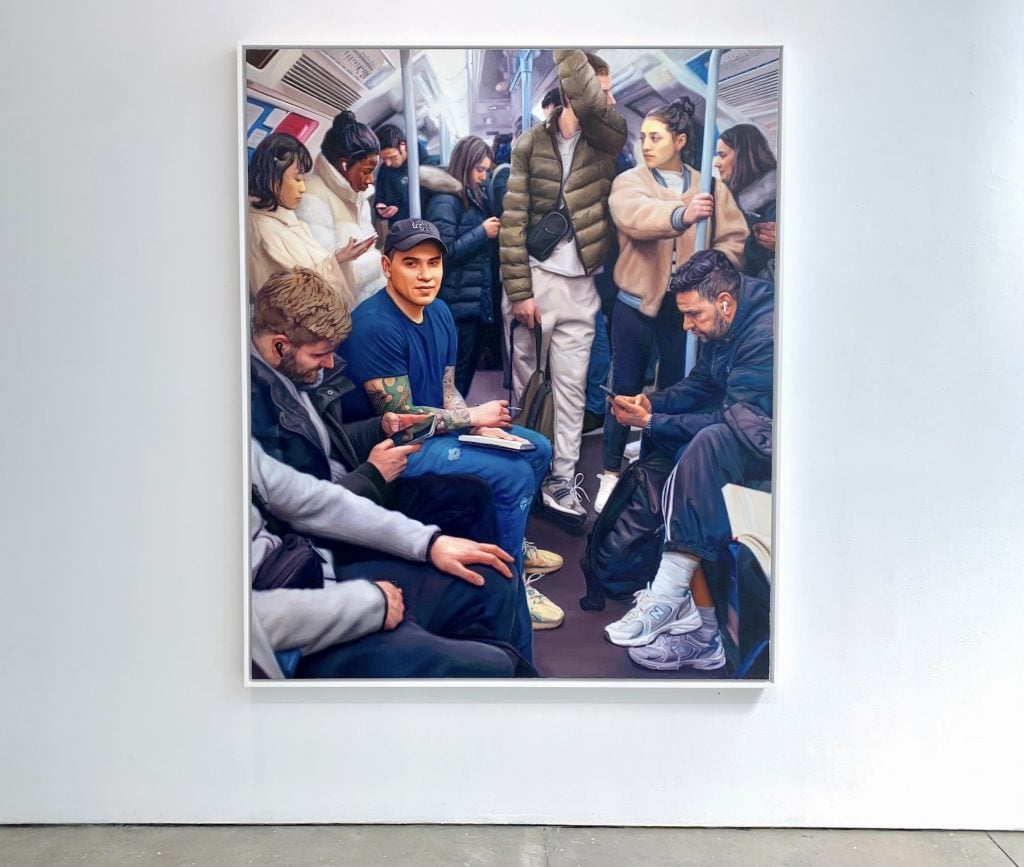
Devon Rodriguez’s self-portrait, featured in “Underground.” Photo by Ben Davis.
Consider Rodriguez’s largest canvas in “Underground,” its big statement (on TikTok, he presents his paintings with the number of hours he has spent painting them—in this case, the number is 680 hours). It is a self-portrait in a crowded subway car. It shows him surrounded by people on their phones, sketchbook in hand. Here, he has rendered his own face at a sharper level of detail than everyone else’s—a nice touch, as if a lens was focusing in on him. That’s the kind of device that gives this work more articulation than the meat-and-potatoes photorealism of the other canvases.
Beyond Rodriguez’s rendering of his own face, the most prominent element in this painting’s composition—in fact, the detail that his gaze seems to be guiding you towards—is the huge hand of the man whose body is mainly cropped out at bottom left. It’s the most prominent detail, but it’s a little wonky. It looks like a small rotisserie chicken. If I had this painting on my wall and had to look at that mitt every day, it would start to bug me.
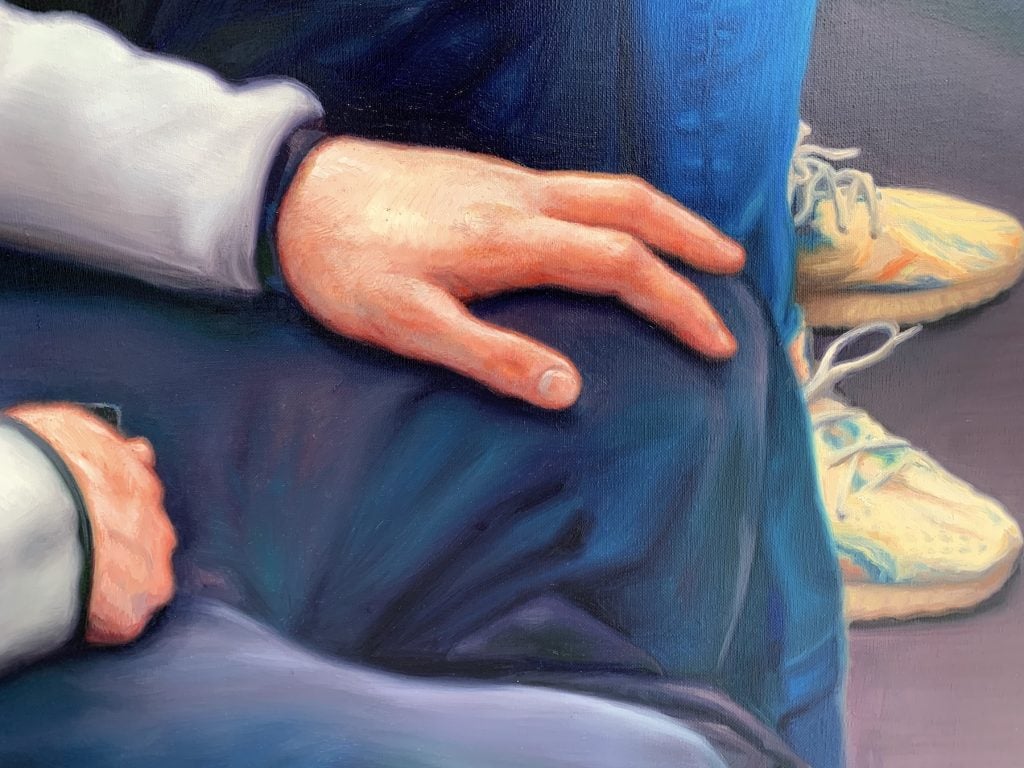
Detail of Devon Rodriguez’s painting. Photo by Ben Davis.
Well, hands are infamously hard to paint. Again: Devon Rodriguez is a talented painter. I just think it’s clear, if we’re honest, that it’s not ultimately his painting technique that is key to what brought the big crowds to the show.
And indeed, the most prominent feature of “Underground” was not that large self-portrait. It was a short UTA Artist Space-created film that played, on a loop, recounting Rodriguez’s personal story and rise to viral mega-fame via TikTok, showing both his encounters with ordinary people and the clips where he stages run-ins with the likes of Ed Sheeran or Jared Leto on the subway.
The aforementioned orange subway seating was installed to encourage you to sit and watch this video, not to sit and look at the paintings. The projection was larger than any of the paintings, dominating the display.
Basically, UTA Artists Space’s curation was very clearly signaling that his social-media celebrity looms far larger than his accomplishments on canvas. The TikTok clips, with Rodriguez’s catchphrase, “Miss, I drew you” or “Sir, I drew you,” are what Rodriguez is famous for.
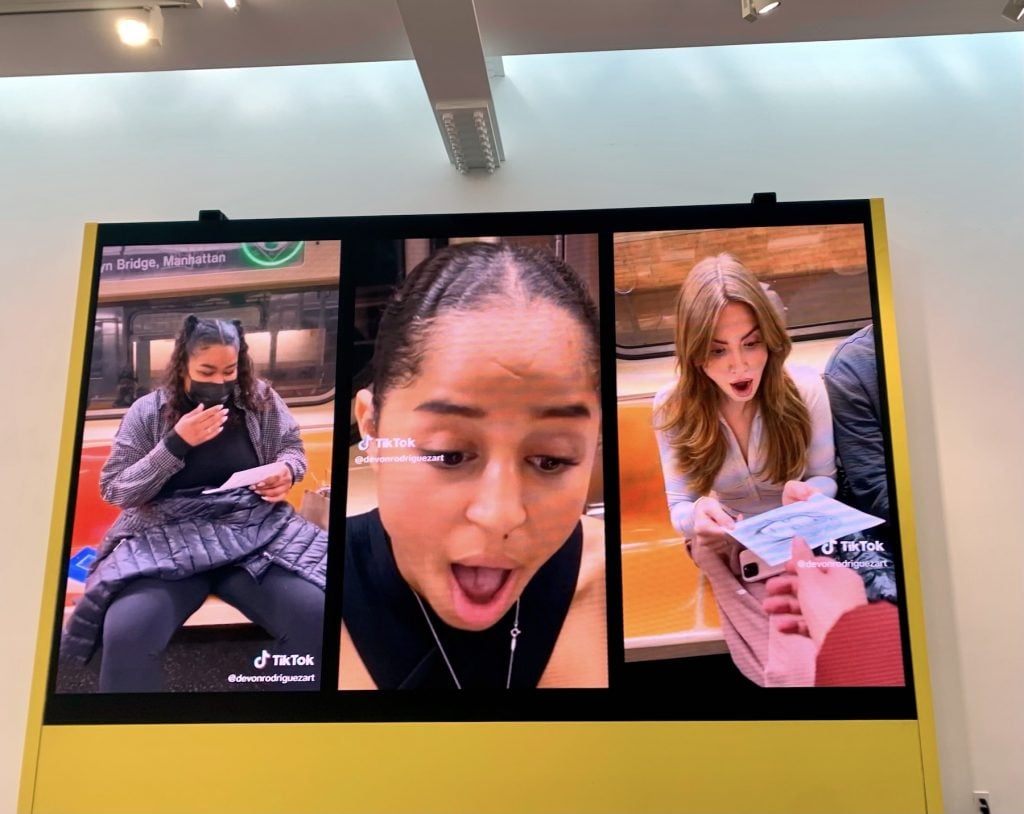
Video by UTA Artist Space telling the Devon Rodriguez story, shown in “Underground.” Photo by Ben Davis.
This represents a craft all its own, quite distinct from the craft of draughtsmanship. Rodriguez explained to Artnews:
You have to have a good hook, a good middle story, and a good ending. And a really good incentive to watch to the end…. The algorithm boosts the videos that get watched the most, and the people scrolling are given the best of the best. All I had to focus on is keeping people on the app, and somehow molding my work into something that’s entertainment.
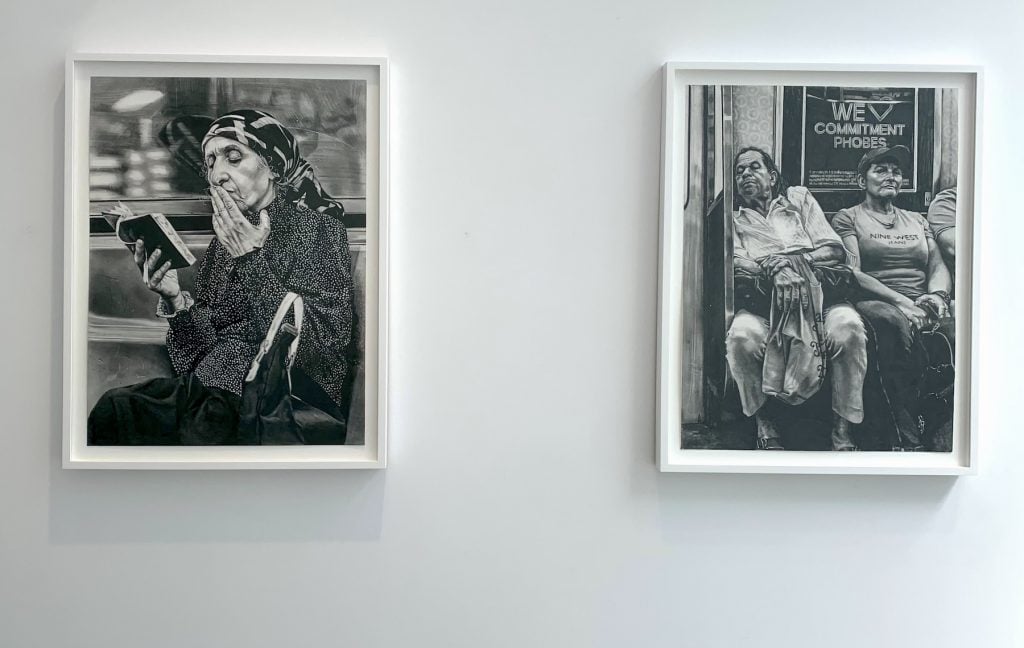
Two drawings by Devon Rodriguez in “Underground.” Photo by Ben Davis.
On some level, the clips are hard not to like. All the same, the too-viral-to-be-true nature of Rodriguez’s rise to fame has inspired an entire genre of YouTube debunker videos, trying to prove that he could not possibly be organically doing what he said he was doing.
My brow furrows watching his appearance on ABC News last year. “You’re able to do it so quickly—what’s the secret?” host Linsay Davis asks. Rodriguez replies, “There’s no secret; it’s just a lot of years of practice.” As they are speaking, the clips ABC plays are of him handing people on the subway what appear to be fully painted, completely dry portraits of themselves, wearing the exact outfits that they are currently wearing. “Fake,” I think.
And indeed, while his clips are staged as if they were spontaneous, Rodriguez has admitted (in that Times story about him moving to Manhattan) that he “gets advance permission from the person he wants to draw and asks how long they expect to be on the subway.” At this point, it seems that everyone involved is basically simply collaborating on a bit of theater to make a nice viral moment.
In some cases, Rodriguez even seems to be now openly making fun of the idea that these are spontaneous encounters, as with a recent video where he pretends to randomly spot Friends actress Courteney Cox walking in Soho. He stops her, asks to draw her—then draws a perfect sketch in under 10 seconds.
If everyone agrees to go along with this kayfabe, it is because a) it is in everyone’s interest to do so, and b) Rodriguez seems like just such a genuinely nice person, someone you root for.
On camera, he has a hard-to-pull-off combination of modesty and bravado. His personal rags-to-riches story—from hardship in the Bronx to painting his way out of poverty—is a big part of the appeal, good material to serve the bottomless media hunger for unthreatening uplift content. There are many, many, many profiles of Rodriguez retelling his origin story; there are almost zero art reviews, where people talk about what makes his artworks work, or not work. His biography was central to the marketing for “Underground,” both on social media and in that in-gallery video.
(On a slightly less uplifting side note, a big character in Rodriguez’s rise has been Keith Rubenstein, the very wealthy property developer behind the infamous 2015 poverty-themed “Bronx Is Burning” party, which brought supermodels and actors to the Bronx to swig champagne in front of bullet-ridden car wrecks and burning trash barrels as part of his push to rebrand Mott Haven as the “Piano District,” to prime it for mega-gentrification along the Williamsburg/DUMBO model. In a 2017 New York Times story, “The Rebranding of the Bronx,” Rubenstein was cited as commissioning a $6,000 portrait from Rodriguez. In the build-up for “Underground,” Rodriguez shouted out Rubenstein as “my good friend,” thanking him for providing the space for the show. I was supposed to interview Rodriguez, but the condition of the interview was that I not ask any questions about Rubenstein.)
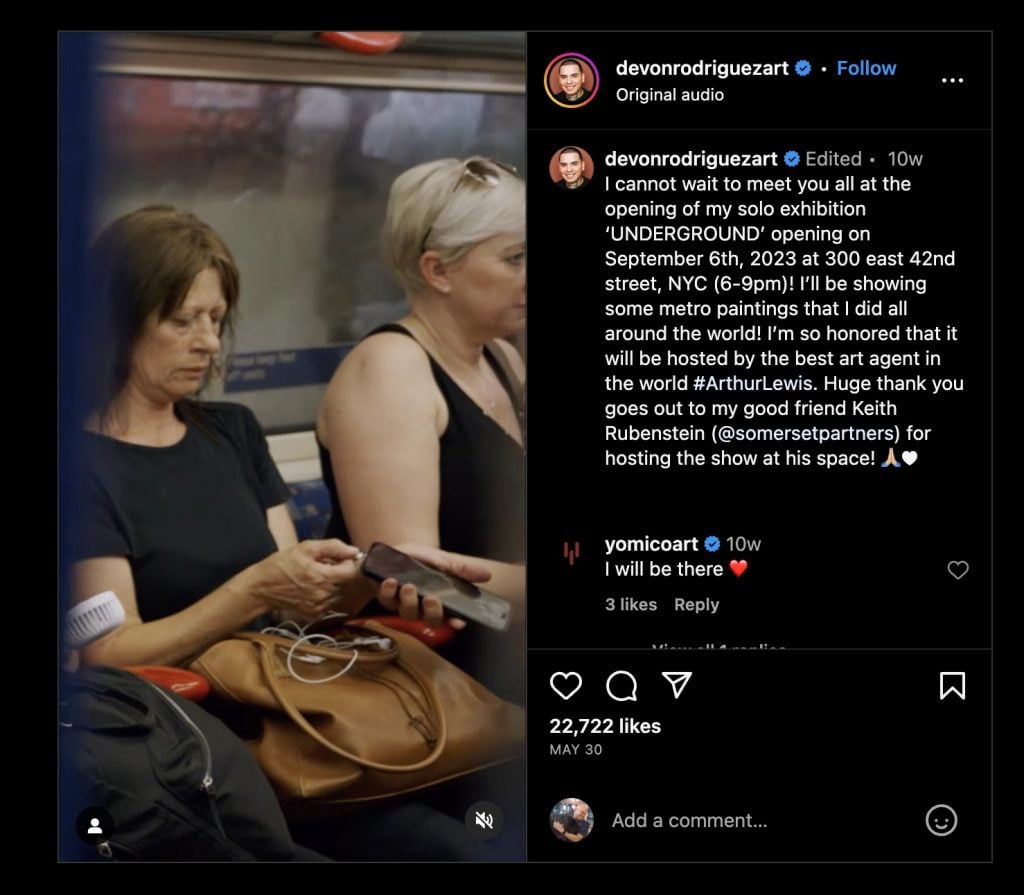
Screenshot of Devon Rodriguez’s Instagram post about “Underground,” shouting out Keith Rubenstein.
Finally, it’s worth saying that the context of Devon Rodriguez’s astronomical rise as the world’s most-followed painter came exactly at the moment of mid-2020, when the world was incredibly fraught so that feel-good stories had a particular charge. It was also when the pandemic had thrown everyone into isolation, so that the only access to new art, for most people, was screen-based.
Back in 2017, I suggested the term Influencer Artist for a kind of organically hybrid creative phenomenon, someone who, because they mainly showed their art via social media, evolved toward producing something that was a mix of conventional art object, performance art, and self-promotion. It seemed as if this hybrid was the direction that these platform contexts nudged art—exactly as Rodriguez has been nudged, from a fairly straight-forward realist painting practice to staging run-ins with celebrities. “Most people in society don’t love art—it’s a niche thing,” he explained to CNN. “So I was thinking, how can I mix that with something most people enjoy, and make it digestible for people.”
Rodriguez’s example is much more wholesome than the types of Influencer Art I mentioned back in 2017, like the now-obscure Allie and Lexi Kaplan, a.k.a. the Kaplan Twins, NYU painting students who started out painting stills from celebrity sex tapes, then realized that posts with themselves in them got more likes, ending up doing seedy performance art. But Rodriguez’s case also feels a bit like Influencer Art assuming its fully realized, most optimized final form.
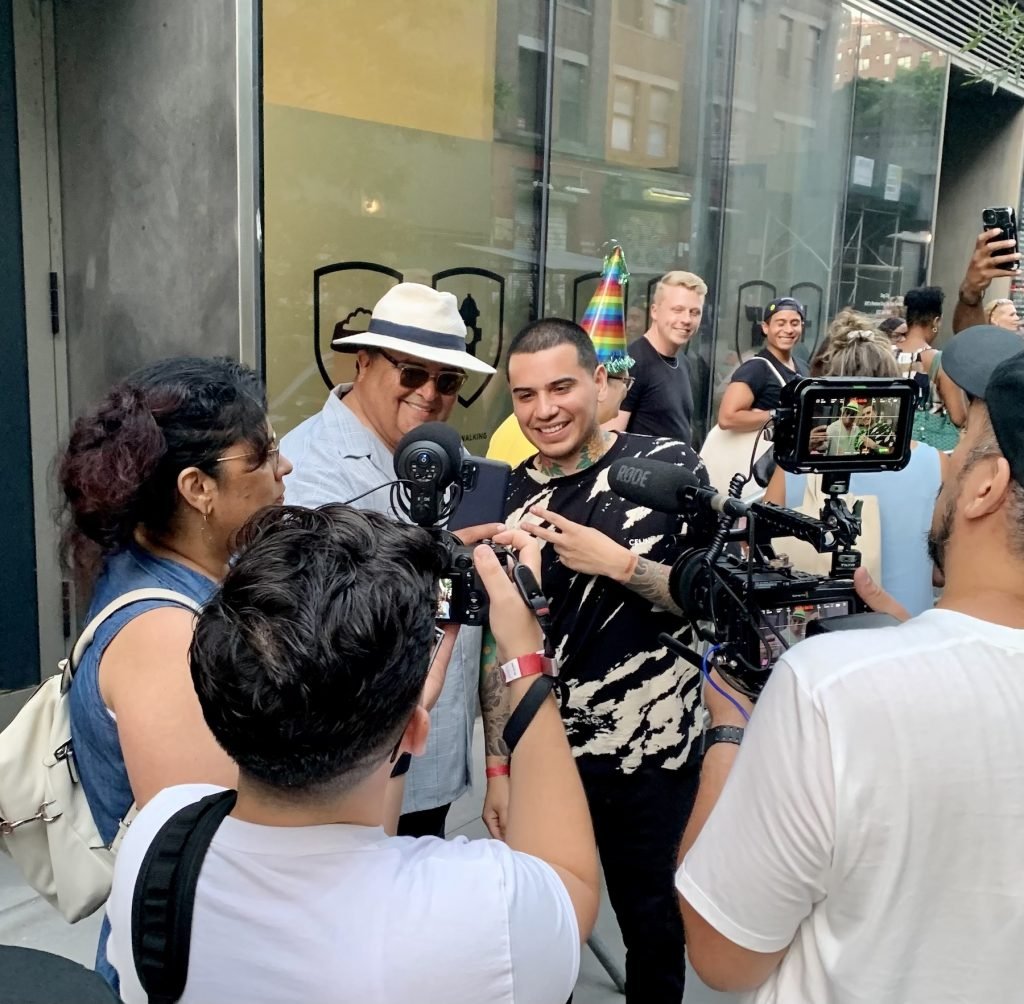
Devon Rodriguez with fans at the opening of “Underground.” Photo by Ben Davis.
In the end, to understand what Rodriguez represents as a creative force, it’s more helpful to compare him to someone like Brandon Stanton, the photographer who built an “empire of empathy” off his Humans of New York photoblog on social media, than it is to compare him to contemporary painters like Kerry James Marshall or Peter Doig. We have to be honest about what’s really being sold here, since the spectacle of Rodriguez’s success is absolutely shaping other people’s aspirations.
It is actually likely that as a role model, Rodriguez is more relatable to young painters who are under what Karen Patel calls the “pressure to presence,” that is, to connect with an audience as a relatable micro-celebrity in addition to maintaining an art practice. The case of Devon Rodriguez is further evidence for the shift in emphasis from consuming art as content, to consuming artists as content.
And we have to take the word “consuming” here in both its senses. Art that rises first through the context of social media, with its hyper-charged trends, is subject to rapid decay in interest if it doesn’t deepen its audience meaningfully beyond whatever gimmick fired the algorithm in the first place. In 2023, Rodriguez is essentially in a race to develop an audience with a more-than-superficial interest in his actual painting faster than his social-media presence is drained of goodwill through over-exploitation.
I’m not totally sure, based on “Underground,” that this is a problem fully resolved—but it’s a problem that is bigger than just him, and I am rooting for anyone who is trying to solve it.